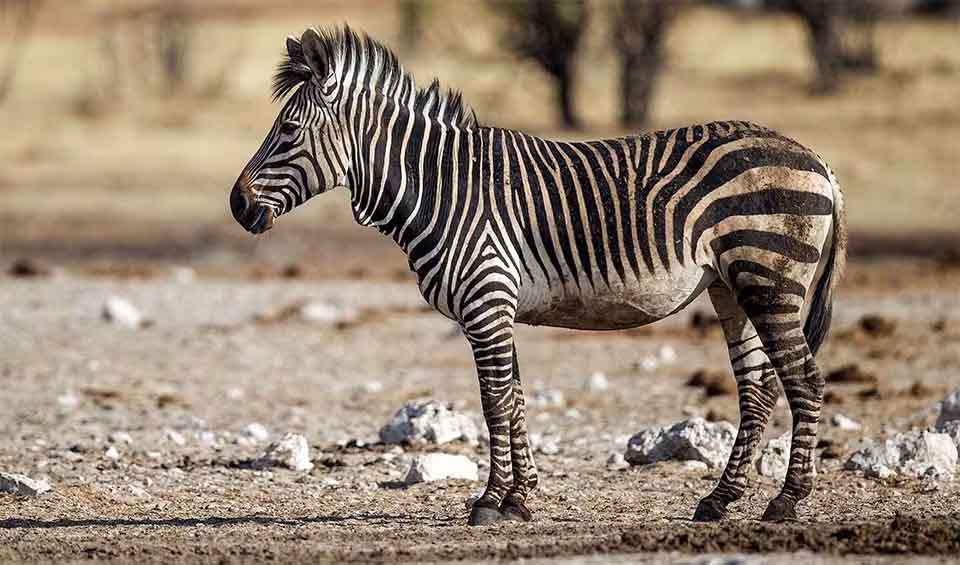Unlike their savannah-dwelling counterparts, mountain zebras have evolved features that enable them to navigate the challenging landscapes they call home. Their physical adaptations, including long ears and narrow, pointed hooves, are not merely distinctive traits but crucial for survival in the rocky environments of the mountains.
One of the most striking features of mountain zebras is their unique striping pattern, which extends down to their hooves, a trait not found in all zebra species. This intricate pattern of stripes is more than just a visual marvel; it serves as camouflage, breaking up the outline of their bodies against the rugged background, helping them to avoid predators. Additionally, the mountain zebra exhibits a remarkable gridiron pattern and a reversal of the direction of hairs along the spine, both unique characteristics distinguish them from other zebra species.
Mountain zebras are not only notable for their adaptations to mountainous living but also for their deep evolutionary roots. They are considered the oldest of all zebra species, with their lineage tracing back to the early Pleistocene. Phylogenetic studies suggest that mountain zebras may share a common ancestry with the Grevy’s zebra, indicating a complex and intertwined evolutionary history among zebra species.
There are two subspecies of mountain zebra: the larger and heavier Hartmann’s mountain zebra, which possesses a horse-like build, and the smaller, slender Cape mountain zebra, which bears a resemblance to wild asses. This diversity within the species reflects the wide range of habitats and ecological niches mountain zebras occupy and their evolutionary response to these varied environments.
However, the survival of mountain zebras faces significant challenges. Human activities have led to the fragmentation of their habitats, isolating populations and increasing the risks of hybridization and inbreeding depression. These anthropogenic pressures threaten the genetic diversity and long-term viability of mountain zebra populations, highlighting the need for concerted conservation efforts.
Distribution
 Angola
Angola Official estimate
Official estimate
 Namibia
Namibia Official estimate
Official estimate
 South Africa
South Africa South Africa
South AfricaDid you know?
- They are similar to plains zebras in appearance but are believed to be bad-tempered.
- They are very fond of dust baths!
- Typical harsh snorts and barking “Qa-ha-ha” as alarm signals are commonly used to alert about predators.
- Their hooves are very hard and pointed, fitted to climb the rocky terrain.
- Bright orange shading surrounding the snout is present in the mountain zebra.
- Hartmann’s mountain zebra prefers the ecotone zones between mountain slopes and dry sandy flats found at the foot of mountain slopes, while Cape mountain zebra inhabit the higher slopes and kloofs.
- Mountain zebra need abundant drinking water; they avoid muddy water. If the water becomes scarce, they were observed to dig up to 1.2m (4 ft) deep holes.
- Today, the Cape mountain zebra is restricted to fenced protected areas and game farms, so its distribution is more fragmented than in historical times.
- Potential threats include Equine sarcoidosis and stochastic events such as droughts.
- Hybridisation between Hartmann’s mountain zebra and Cape Mountain zebra takes place in the Western and Eastern Cape.
- However, this is more of a threat to the Cape mountain zebra, as the core populations of Hartmann’s mountain zebra remain unaffected by potential hybridization.
- They evolved around 1-2 mya, along with the African wild ass.
Anything we've missed?
Help us improve this page by suggesting edits. Glory never dies!
Suggest an editGet to know me
Terrestrial / Aquatic
Altricial / Precocial
Polygamous / Monogamous
Dimorphic (size) / Monomorphic
Active: Diurnal / Nocturnal
Social behavior: Solitary / Pack / Herd
Diet: Carnivore / Herbivore / Omnivore / Piscivorous / Insectivore
Migratory: Yes / No
Domesticated: Yes / No
Dangerous: Yes / No




